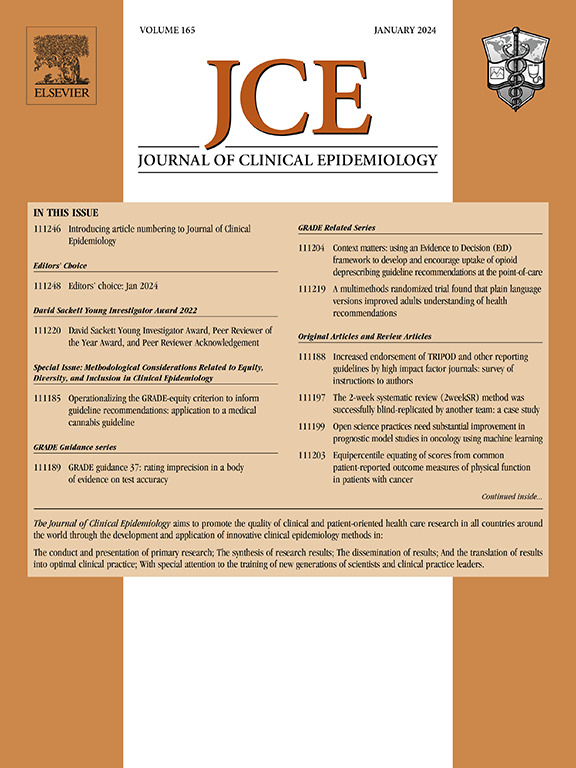报告患者和护理人员参与确定和设计医疗保健干预措施:IDEAS框架
IF 7.3
2区 医学
Q1 HEALTH CARE SCIENCES & SERVICES
引用次数: 0
摘要
背景与目的患者和护理人员的参与可以优化研究的相关性和吸收。然而,关于报告患者和护理人员参与确定和设计卫生保健干预措施的方法的指导很少。本研究旨在制定一个报告框架,使患者和护理人员参与确定和设计卫生保健干预措施,以提高所使用方法的透明度。方法广泛检索电子文献数据库,查找报告患者和护理人员参与干预的指南、框架、综述和初步研究;确定了截至2024年4月的研究。归纳地拟订了一份全面的报告项目清单。识别和设计医疗保健干预(IDEAS)框架在一系列报告患者和护理人员参与干预的初步研究中进行了试点。结果19项二级研究(如指南、框架和综述)和41项初级研究被用于制定IDEAS框架的报告项目。IDEAS框架包括14个报告项目,涵盖5个领域:目的(即患者或护理人员的作用、干预措施的类型和范围、考虑的标准(如可接受性、可行性);使用的理论或框架;总体(即纳入标准、识别和选择以及特征);参与方式(即参与过程、频率、持续时间和报销);以及产出和影响。每个报告项包括一个描述符和示例。结论IDEAS框架有助于在确定和设计卫生保健干预措施时确保描述患者和护理人员报告过程的透明度。最终,这可能支持干预措施的设计,以满足患者和护理人员的需求、偏好和优先事项。患者和护理人员参与识别和设计卫生保健干预措施有助于提高干预措施的可接受性、吸收性和影响。然而,很少有指南涉及报告患者和护理人员参与制定保健干预措施的情况。我们对指南、框架和初步研究进行了详细的搜索,以发展患者和护理人员参与识别和设计医疗保健干预(IDEAS)框架的报告。IDEAS框架由14个报告项目组成,涵盖五个领域:参与的目的、使用的理论或框架、参与的患者和护理人员人数、参与模式(即参与过程)以及产出和影响。IDEAS框架可用于描述患者和护理人员参与确定和设计卫生保健干预措施的情况。本文章由计算机程序翻译,如有差异,请以英文原文为准。
Reporting the involvement of patients and caregivers in identifying and designing healthcare interventions: the IDEAS framework
Background and Objective
Patient and caregiver involvement can optimize the relevance and uptake of research. However, there is little guidance on approaches for reporting the involvement of patients and caregivers in the identification and design of health care interventions. This study aims to develop a reporting framework for involving patients and caregivers in identifying and designing health care interventions to improve transparency in the approaches used.
Methods
Electronic literature databases were extensively searched for guidelines, frameworks, reviews, and primary studies that reported patient and caregiver involvement in interventions; studies identified up to April 2024 were identified. A comprehensive list of reporting items was inductively developed. The IDEntifying And designing healthcare interventionS (IDEAS) framework was piloted with a diverse range of primary studies that reported patient and caregiver involvement in interventions.
Results
Nineteen secondary studies (eg, guidelines, frameworks, and reviews) and 41 primary studies were used to develop the reporting items for the IDEAS framework. The IDEAS framework includes 14 reporting items that cover five domains: purpose (ie, role of patients or caregivers, type and scope of interventions, criteria considered eg, acceptability, feasibility); theory or framework used; population (ie, inclusion criteria, identification and selection, and characteristics); mode of involvement (ie, process of involvement, frequency, duration, and reimbursement); and output and impact. Each reporting item includes a descriptor and examples.
Conclusion
The IDEAS framework can help ensure transparency in describing the process of reporting patients and caregivers in identifying and designing health care interventions. Ultimately, this may support the design of interventions that address the needs, preferences and priorities of patients and caregivers.
Plain Language Summary
Patient and caregiver involvement in identifying and designing health care interventions can help improve acceptability, uptake, and impact of interventions. However, there is little guidance that addresses the reporting of the involvement of patients and caregivers in developing health care interventions. We carried out a detailed search for guidelines, frameworks, and primary studies to develop the reporting of the involvement of patients and caregivers in IDEentifying And designing healthcare interventionS (IDEAS) framework. The IDEAS framework consists of 14 reporting items that cover five domains: the purpose of involvement, the theory or framework used, the population of patients and caregivers who were involved, mode of involvement (ie, process of involvement), and output and impact. The IDEAS framework can be used to describe the involvement of patients and caregivers in identifying and designing health care interventions.
求助全文
通过发布文献求助,成功后即可免费获取论文全文。
去求助
来源期刊

Journal of Clinical Epidemiology
医学-公共卫生、环境卫生与职业卫生
CiteScore
12.00
自引率
6.90%
发文量
320
审稿时长
44 days
期刊介绍:
The Journal of Clinical Epidemiology strives to enhance the quality of clinical and patient-oriented healthcare research by advancing and applying innovative methods in conducting, presenting, synthesizing, disseminating, and translating research results into optimal clinical practice. Special emphasis is placed on training new generations of scientists and clinical practice leaders.
 求助内容:
求助内容: 应助结果提醒方式:
应助结果提醒方式:


